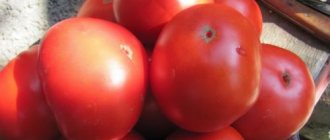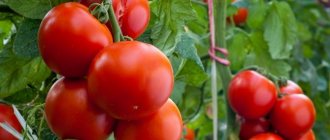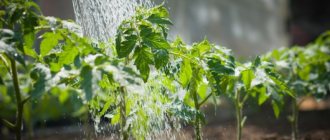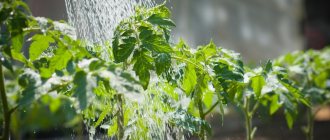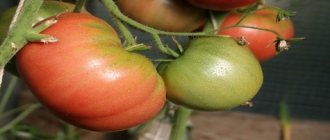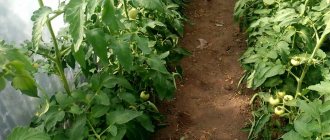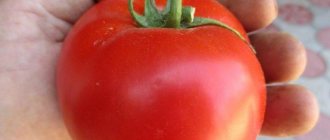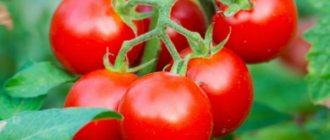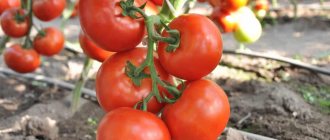Description of the variety
Orange tomatoes are a semi-determinate (that is, with unlimited growth) mid-season variety of tomatoes. This variety loves warmth, so it is more suitable for greenhouses.
The vegetable is tall and occupies less area than other types of tomatoes. The height of the bush sometimes reaches 150 cm, the plant branches heavily and needs support. The bushes are covered with medium-sized foliage. Inflorescences are formed above 8-9 leaves. By type, subsequent inflorescences are divided into simple and intermediate and are formed after 2-3 leaves.
Advantages and disadvantages
The advantages of the type include:
- high productivity;
- aesthetic appeal;
- excellent taste;
- pleasant aroma;
- compactness of bushes;
- health benefits.
The fruits of the Orange variety normalize the functioning of the gastrointestinal tract and can be used for baby food.
The variety also has disadvantages: the vegetable is very tender, which makes it difficult to transport and impossible to store for a long time . In addition, the bushes must be tied up and pinched, otherwise the yield will be significantly reduced. Orange cannot be called precocious. The fruits are harvested 100-120 days after the seedlings are planted in the ground, and with direct sowing you will have to wait even longer.
Fruit characteristics
Tomatoes have attractive bright yellow or orange skin with a few longitudinal yellow stripes. Tomatoes are round in shape, weigh 0.2-0.3 kg, and in particularly favorable conditions, the weight of vegetables sometimes reaches 400 g. The skin is soft but durable, capable of protecting the vegetable from cracking. The smell is slightly sweet and pleasant.
The tomato pulp is sweet and fleshy with a slight sourness, it contains 3.2% sugar and 6.2% dry matter. When you cut a tomato inside, you can see 2-3 chambers with a small number of seeds. The vegetable is often consumed fresh. This allows you to preserve its aroma and beneficial properties. The tomato is suitable for dietary nutrition and allergy sufferers, as well as for making pastes and juices. The fruits are also used for preservation for the winter.
Yellow tomatoes are recommended for people who are deficient in carotene and vitamins. The vegetable normalizes the functioning of the gastrointestinal tract and eliminates characteristic diseases.
On a note. The Orange tomato variety is non-hybrid, so seed material can be harvested independently to grow the crop in the future.
Nuances of cultivation
Although the Orange tomato is intended for growing in the southern regions, it is still done everywhere. The variety grows well in temperate climates, as it is mainly cultivated by seedlings.
Before sowing, the seed material is treated with a growth stimulant and disinfected in a solution of potassium permanganate. 60 days after the first shoots appear, the seedlings are ready to be transplanted into open ground.
Breeding features
Thanks to domestic breeders, the tomato was bred in 2000. Since the crop was originally created for private gardeners, it is not customary to grow such tomatoes on an industrial scale.
Productivity and fruiting period
In a greenhouse, the crop produces more yield than in a garden bed without film cover: up to 6-7 kg of fruits are harvested from one bush per season. From one plant that grows in open ground, 3-4 kg of tomatoes are harvested. From 1 sq. m, vegetable growers receive up to 22 kg of tomatoes.
Full ripening of the Orange variety occurs 3-3.5 months after planting. Tomatoes ripen in stages. Fruiting in the greenhouse occurs earlier than in open ground (at the end of July), and continues until mid-October.
For your information. Fresh Orange tomato is unsuitable for long-term storage.
What type are they?
Late-ripening tomatoes are most often indeterminate. This means that such bushes grow throughout the entire growing season. These varieties are tall and can reach two meters or more in height.
For example:
- The Giraffe variety reaches a height of 1.8 meters or more.
- De Barao Giant is a vigorous bush, reaching 4 meters in height.
- Cosmonaut Volkov stretches up to 2 meters in height.
However, among the late-ripening varieties of tomatoes you can also find a determinate type, whose bushes are limited in growth.
For example:
- Rio Grand variety - reaches from 0.7 to 1 meter.
- Titan grows up to 40 cm.
Important! Open ground conditions are preferable for growing determinate varieties. Tall tomato varieties and hybrids are usually planted in greenhouses.
Growing tomatoes
To obtain a high-quality harvest, care should be taken to properly prepare the soil and the plant itself. The Orange tomato variety is grown both by seedlings and by direct sowing in open ground.
On a note. Before sowing, seed material must be heated at a temperature of 50°C and cooled in cold water or soaked in a slightly pink solution of potassium permanganate for 20-30 minutes. This will strengthen the plant’s immunity and help avoid diseases and pests.
Landing
The first days of March are the best time to plant the variety. The drainage is placed at the bottom of the container, then covered with substrate. Organic fertilizers are also added. To make the seedlings germinate faster, place the container in a warm place. After 60 days, the bushes are transferred to a permanent place of growth.
If you decide to use the direct planting method (sow tomato seeds directly into the garden bed), this should be done in early May, in sunny and sheltered areas. With such planting, you should not count on a quick harvest: the fruits will take much longer to ripen.
Care
Compliance with the rules of agricultural technology is important for growing any crop. Knowing some of the nuances will help you achieve high yields without much difficulty.
Tomatoes are watered as the soil dries, but no more than 2-3 times a week. One bush consumes 3-4 liters of water. Do not forget that the crop is watered exclusively at the root. You cannot water under the scorching sun; it is better to choose morning or evening time for this.
Between water procedures, the soil around the bushes must be loosened, at the same time ridding them of parasitic weeds, which are not as harmless as they seem at first glance. If you do not remove weeds on time, all fertilizing, watering and other measures to care for tomatoes will be useless. The plant will wither and get sick, and everyone’s unloved “weeds” will turn green, grow and prosper.
During the growing season, the fruiting crop is fed at least three times. It is better to use organic matter as fertilizers. A week after planting the plants in open ground, perform the first fertilizing with manure at the rate of 1 kg of fertilizer per 1 liter of water. Next time, fertilize 2-3 fruit clusters during the flowering period.
Gardeners also recommend using manure, but with the addition of 2-3 g of potassium permanganate and copper sulfate per 10 liters of the mixture. The plants are fertilized for the last time during the ripening of the first fruits: manure dissolved in water (1:1) is also used.
On a note. Tomatoes contain a large amount of useful substances. Regular consumption of tomatoes reduces the risk of depression and cancer. Another big plus of these fruits is that 100 g of vegetable contains only 22 kcal.
Landing
In medium-wide conditions, the Orange tomato is planted as seedlings. The timing of sowing seeds depends on the climatic characteristics of the region and greenhouse conditions. For early fruit ripening, planting begins in February-March, for mass harvesting - from mid-March. Seedlings are planted in a permanent place at the age of 45–60 days.
For planting use:
- universal primer;
- a mixture of humus (compost, manure or leaves) with garden soil 1:1; add ¼ volume of river sand or vermiculite to the loams to loosen the soil and ensure good moisture permeability.
Seeds from packages can be sown immediately; self-collected ones are pre-treated with a fungicide solution and kept in a weak solution of manganese. When sowing in peat tablets, individual cups or pots, “pecking” is recommended: the seeds are placed in a damp cloth, periodically moistened, and left until a sprout appears. Such seed material is deepened into the soil by 5 mm, moistened, and mulched with dry soil on top.
Growing seedlings
The recommended temperature range is +18…25°С. When the temperature drops to +15°C at night, root rot may develop. Picking plants from a common planting container is carried out after the appearance of 3 main leaves (cotyledons are not taken into account). Once every 2 weeks, fertilizing is carried out; the sprouts need nitrogen, phosphorus (for the development of the root system), and potassium. The ratio of components is 1:2:1.
Landing in the ground
Planting density is 1 seedling on an area of 40x50 cm. Plants are transferred to the holes by transshipment without destroying the root ball. Plants that are too long are laid in a spiral; in this case, the bush develops a powerful root system. The soil is pre-spilled with biofungicide solutions to prevent fungal diseases. In sunny weather, tomatoes are shaded during the first week so that the plants adapt better.
Growing conditions
Orange tomatoes require constant pinching. The shoots are pinched as they appear so that they do not take away the vitality of the plant. Most often, the bush is formed into 1-2 stems. A month before the end of the growing season, the tops of the plant should be pinched and small inflorescences removed.
Diseases and pests
The variety has strong immunity, but under unfavorable conditions it is sometimes affected by diseases. To prevent the risk of illness, there are certain preventive measures.
For example, if there is a risk of mosaic infection, it is better to use one-year-old seeds for planting. And if there is a possibility of fusarium disease, prevention is carried out in stages, in the first month after planting. For this purpose, Trichodermin is used.
The most dangerous disease is bacterial wilt of the plant. Affected seedlings die within a few days. Harmful microorganisms appear because the seeds were not properly treated before planting. For treatment, the plant must be treated in time with the Fitolavina-300 solution. Sick and dead bushes are removed and burned to avoid infection of neighboring plants.
Breeders claim that Orange is less susceptible to late blight than other varieties. However, for prevention, it is better to treat the bushes with effective means:
- "Barrier";
- "Barrier";
- "Fitosporin".
Preparations containing copper will help protect the crop from fungal diseases.
Orange is a tall variety, which entails certain risks of disease. Tomatoes begin to rot if they come into contact with the ground. Installing a trellis system will help to avoid this; it will also be easy to treat fruits from small pests.
Insects often parasitize the fruit. To avoid this, the bushes are treated with appropriate pesticides, a soap solution (100 g of substance per 10 liters of water) or garlic infusion in the same proportion (the garlic must be crushed and the mixture allowed to brew for one day).
For your information. Despite Orange’s strong immunity, preventive measures should not be ignored, because every year viruses mutate, adapting to new blockers and learning to bypass them.
The described process of growing tomatoes may seem complicated. However, proper formation of the bush produces a rich tomato ovary. A one and a half meter bush can produce a bountiful harvest and at the same time save space on the site. Beautiful orange fruits with juicy pulp will decorate the garden and delight the taste. The Orange tomato is a worthy competitor to the traditional red tomato.
Pest and disease control
The Orange variety is resistant to late blight. With good care, it does not suffer from leaf and fruit rot or other dangerous tomato diseases. After cool and rainy weather, it is advisable to carry out preventive spraying with copper-containing preparations or a solution of Bordeaux mixture.
Among the pests, tomatoes can be affected by slugs, cutworms, wireworms, and Colorado potato beetles. The easiest way to combat them is with agrochemicals; they should be sprayed at the first signs of damage.
The harvest ripens gradually, but quite smoothly
Reviews from gardeners
Most summer residents have long been familiar with Orange tomatoes and actively grow them. They highlight the unique taste of the fruit and high yield. The variety also makes it possible for people who are allergic to red tomatoes to consume these vegetables. Reviews about Orange tomatoes are mostly good.
Tatyana, Volgograd: “I’ve been growing Orange for three years in a row. The description of the variety and the photo on the package with seeds convinced me that this species is worthy of attention. I liked the tomatoes for their unsurpassed taste. Before that, I really liked the Pink Giant, but after making a salad with Orange tomatoes, my whole family stopped recognizing other tomatoes. The grandchildren ask me to make them “red” juice, they really liked it. I grow a lot of tomatoes: enough for food, for sale, and for canning. I recommend this variety to everyone."
Evgeniy, Tula: “I learned about Orange from a neighbor in the country. He once treated me to a gathering, after which I immediately asked him for seeds. I don’t let anyone near my tomatoes; I grow them myself. When my wife saw yellow tomatoes in the garden, she laughed that I was growing oranges. I liked the fruits for their taste, aroma, structure and large size. I couldn’t pull my wife by the ears. I wouldn’t say that the yield is greater than that of other varieties, but not less. I’m happy and will continue to grow.”
Svetlana, Ivanovo: “We have always grown tomatoes in the country. With the advent of my granddaughter, they began to plant yellow varieties, since she has diathesis and is allergic to everything red, and the child loves tomatoes and picks them straight from the garden - you can’t keep track of them. The whole family really liked the Orange variety. These tomatoes do not cause any reaction other than positive in my granddaughter, even if she drinks the juice. Overall I can say that the variety is very good. This is a worthy replacement for red tomatoes. They don’t require any special care.”
Recipe: sliced orange tomatoes for the winter
Ingredients for 5 1 liter cans:
- 1-1.2 kg of not overripe orange fruits;
- 2 medium sized onions;
- 15 cloves of garlic;
- a bunch of parsley and dill;
- 5 bay leaves;
- 10 pieces of allspice;
- 30-35 pieces of black pepper;
- 1 hot pepper;
- 10 tbsp. sunflower oil.
Marinade:
- 1 liter of water;
- 1 tbsp. salt;
- 3 tbsp. l sugar;
- 50 ml vinegar.
Wash the jars, sterilize with boiling water or heat in the oven. Next in order:
- Place bay leaves, 2 allspice and 6-7 black peppercorns on the bottom.
- Divide the hot pepper into equal 5 parts and place one piece in a jar.
- Cut the orange tomatoes into large slices (4-6 pieces). Garlic - in thin slices, onion - in rings.
- Place the tomatoes loosely in jars, topping with onions and garlic. Place 1 sprig of parsley and 2 dill in the center.
- Next to the top are tomatoes and garlic and onions.
- Boil the marinade, pour into jars, cover with lids and sterilize for 15 minutes from the moment bubbles appear in the jars.
Then roll it up and put it aside for storage.
